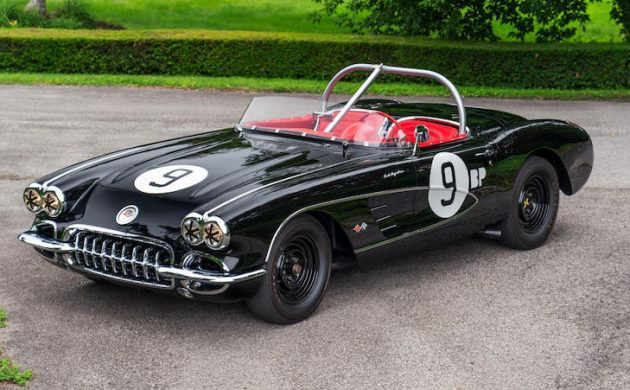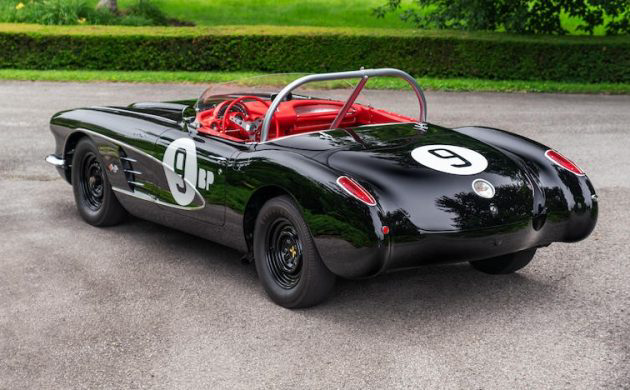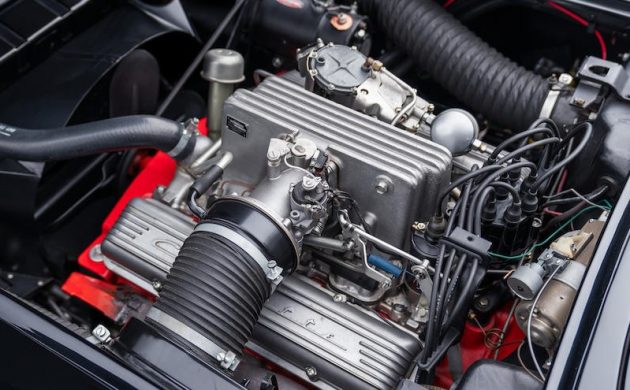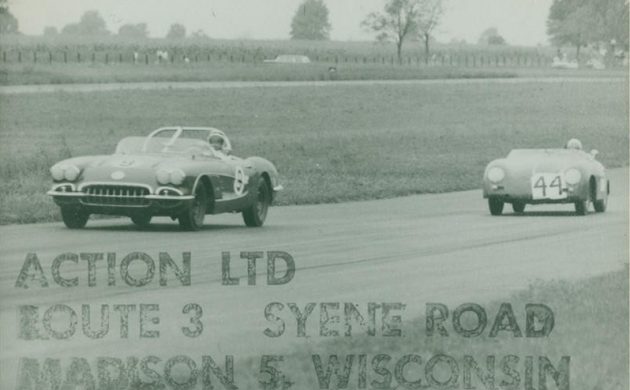While a steady diet of barn-found cars is what one would expect on Barn Finds, we deviate from time to time to marvel at other automotive categories that are generally not found in barns or garages. Today, we have just such a subject in the form of a 1959 Chevrolet Corvette set up for Sports Car Club of America (SCCA) racing. As is usually the case, there is a story. This spectacularly restored road racer is to be auctioned in Carmel, California on August 13th and is available, here on Bonhams for an estimated value of $200,000. Thanks to my colleague Adam C for this exceptional find!
The original owner of this ‘Vette, Gene Cormany – VP of the Zollner Piston Company, attended SCCA driving school in 1958 and then purchased this Corvette the following years. The listing goes on to state, “He raced this car regularly throughout the Midwest in 1959 and 1960, scoring twelve top-three finishes including four wins out of 22 events“. After passing through another owner, this Chevy underwent a full restoration in the’80 with the intention of returning it to its 1959 racing livery. In that undertaking, what sounds like a different than the original major component was swapped in place – more on that to follow.
According to Corvsport, of the 9,670 Corvettes produced for ’59, 1,594 were finished in Tuxedo Black with 496 of those being two-tone, i.e. finished with contrasting coves. The late ’50s racer vibe is well represented with the cut-down windscreen, rollbar, taped headlights, “meatball” number board, goldline tires, and steel wheels. The convertible top is referenced as being white but there are no images of it included.
The top Corvette power option for 1959 was a 290 gross HP, 283 CI, fuel-injected V8 engine and that’s what’s in place here but that’s where things get confusing. The listing states, “The relationship between this Corvette race car and the first Scaglietti Corvette developed in the late 1980s. The previous owner of this Corvette racer had purchased the original engine and fuel injection unit from the first Scaglietti Corvette with plans to install it into his race car. That motor was removed from the 1959 Scaglietti Corvette in order to get more power to be competitive at the vintage races. The engine was then saved until the race car was ready to be restored back to its period race glory“. Following through, it sounds as if the engine that is currently in place is this ‘Vette was originally used in a Carroll Shelby project car known as a “Scaglietti Corvette” due to its alloy body which had been developed by Sergio Scaglietti. Not surprisingly, an optional four-speed manual transmission is connected to the back of the fuelie engine. There is no mention made as to this Corvette’s current operating prowess.
The interior, as beautiful as it is, doesn’t really portray a race car bearing. Other than the roll bar, racing belts (not harnesses), and windscreen, it appears as a stock Corvette interior, albeit one that is in fine shape. One would assume gauges other than factory pieces would have been utilized but maybe that wasn’t the case 62 years ago and in this class of B-Production racing.
This $5,227 Corvette (that was a lot of cabbage in ’59!) is also equipped with heavy-duty suspension, 15×5.5 inch steel wheels and a positraction axle. Other high-performance options that were Corvette available in ’59, but not included, were sintered metallic brakes and a twenty-four-gallon fuel tank. This was an impressive road car in ’59 and still is today, thanks to its meticulous restoration and aftercare. Its well-documented provenance should help it reach its projected estimate, wouldn’t you agree?








A great piece of history
What they didn’t mention about the engine’s “prowess”, was that it “ran when parked”.
Goodwood revival material!
The 1959 Austin Healey Sprite that we bought in ’89 was built in 1966. At that time both seats were required to be in the car by SCCA. As more safety equipment like onboard fire systems were required SCCA went to a one seat requirement so as to provide room for the equipment. As in the Sprite, there’s not a lot of room for anything extra in the car due to the small size, especially the early cars that didn’t have a trunk lid along with the Corvettes. Hard to see in the picture but the entire passenger side is full of battery, oil accumulator, ignition and fire system.
The Bonhams’ listing says the car was “ordered” with a white top, not that it currently has one. There is no way to install a soft top on this car, with the roll bar in it, since the roll bar occupies the space where the top’s hinges would mount. This is a problem encountered by everyone trying to put a roll bar in a first generation Corvette.
Bobhess is correct about the SCCA requiring both seats early on, and most of the rest of the stock interior and gauges too. In the 50’s and early 60’s, cars racing in SCCA Production classes (AP, BP, etc) were required to be pretty much stock production cars, other than some limited modifications and safety equipment. Even into the early 70’s, cars racing in the Trans Am Series still retained their stock interior door panels.
I won’t be surprised if this Vette goes for 7 figures.
I’m baffled as to what planet I’m living in when this will bring seven figures. Sure there is a nostalgic value, but this was a $1000 car in 1967 due to its backward chassis design. Zora could only accomplish so much. I would gladly pay $100k for the stone stock version, but not this edition. Must be an age thing,right?
@Dave- Not always an age thing. I’m 68+ and I truly can appreciate the significance of this car but it is offered and valued by an Auction House that would probably deny me entrance at the door. I drive my 1995 base Corvette as much as I can and I chatted with a gentleman driving an amazing 2019 Z06 Corvette at my local supermarket parking lot yesterday. I would rather pay the $100,000 for the Z06 and drive the wheels off it. Each to his/her own!
There were a total of THREE rolling chassis Corvettes sourced from the KY factory by Ed Cole as a favor to a guy named Gary Laughlin who had several Chevrolet dealerships. Only one of the three cars was completed by Scaglietti before the top GM brass heard about the plans, and the project was quickly stopped by GM. The other 2 were sent back to the US in an unfinished state. The second car [Blue color] was bought and finished by Jim Hall. The third car [Dark Red] was offered to Carroll Shelby, but he declined to buy it, so it was sold off to a private person, as-is, unfinished. All three are today fully accounted for, and restored.
Only the first car was a fuelie. It was painted bright red. The other 2 cars had twin 4-barrel carbs. In all the research I’ve done, I have not been able to find anything that would indicate the first car doesn’t have it’s original engine. I’m not saying this listing is wrong in claiming this is the original Scaglietti fuelie engine, but I would suggest anyone with a genuine interest in this car should do their homework.
As even the 2nd & 3rd Scaglietti cars are now 7 figure vehicles, I would think the current owner of the first car would be winning to pay $200K to obtain the original engine, switch motors, then sell this car again for less. That way he would have the matching engine and chassis on Scaglietti #1.
And a point to ponder;
In 1961 Carroll Shelby was offered the 3rd Scaglietti Corvette, an unfinished light weight alloy coupe with the twin carb setup. He declined to buy the car. I wonder what might have happened had he finished this Corvette and became successful racing Chevrolets, instead of creating the Ford powered Cobra cars?
“KY” plant? This car was built in St.Louis, MO
Frank,
My mistake, for some weird reason I had Bowling Green on my mind. In 1959 that plant had been making Chrysler Airtemp equipment!
you’re one of the only guys I’ve seen on here to preach the truth, I was in LA buying a 1960 corvette a few months back and the #3 Scag is now owned by the Peterson Museum its downstairs in the vault, they refused to lift the hood for me so no idea what engine is in it. the car actually hasn’t been restored or totally put together, the mirrors are still off and it sits as delivered from Italy. I share your thought that the engine is in no way the original #1 Scag engine, I would love to be proven wrong and am still waiting. there are so many wrongs in this whole writeup on this car that it really cripples the credibility of the NCRS folks and doing due diligence in their research. my dad owned this car from Jan 1960 thru the mid 80s i learned to drive stick in this car and have a lot of hours working on her as a kid and going to cruise-ins with my dad. it’s a shame someone has paid what they’ve paid for false provenance. Not that the car doesn’t have a ton of it it’s just a shame someone would lie for profit.
Bill you are 100% correct about the number 1 car having the FI engine, it currently resides at the Peterson museum in LA. O was told by their curator that the number one car was Carol’s, it is still in unfinished condition with no outside mirrors. But the FI engine is in the car.
I owned a ’59, 2 fours 270 hp and I will vouch for performance. 140 mph at 7000 rpm. Handling wasn’t bad for an old style chassis.
Had a ’61, same set-up, four speed … nailed it and my wife’s grandfather yelled reaching for the bar in front because he thought he would slide out the back … wouldn’t pass a gas station but who cared in ’74 …
If this blog is still active, any one reading this 50% of the history on this car is incorrect and the restoration as beautiful as it is is 80% incorrect. Truth #1 yes this car was owned by Gene Cormany in 1959. False #1 he raced the car in 1959 only, he ordered a new 315 horse 1960 in Honduras Maroon and was very disapointed when they never delivered the alluminum heads and 315HP. that being said, Truth #2 in January of 1960, Gene sold the 59 Corvette to Roland E. Gorman (Known to Duntov as Lt. Ron). He raced the car in 1960. false #2 all of Genes racing wins were in his 1960 Honduras Maroon Corvette #9. Gene never registered his 1960 serial # with SCCA so all of his racing accomplishments were recorded under the 1959 serial #. Truth #3 the 1959 Corvette never debuted the #9, that was Genes # in 1960, all the pictures that are shown with this car are gene in 1960 with the #9 in the meatballs on a Honduras Maroon car. if you look close enough you can also see the trailer hitch balls on the front Bumperets which were used to flat tow the car to the race track. Buyer be ware as I’ve had this info recorded also in the corvette race car registry but know one has ever done due diligence and read through the smoke, they just want a piece of history even if its false. Gene and Roland Gorman were best of friends back then as were their wives. Truth #4 Roland Gorman is my father, he is still alive and can verify all that I’ve written in this blog and has done so VIA phone interview with the corvette race car registry. This was written on 01/24/2023 By. James P. Gorman Son of Roland E. Gorman.
Blog still active? Barn Finds is one of the most visited classic car sites online!